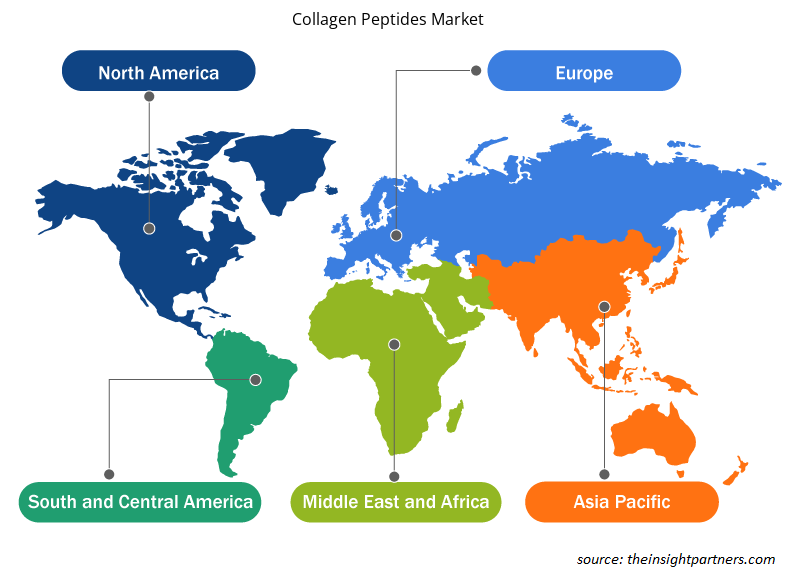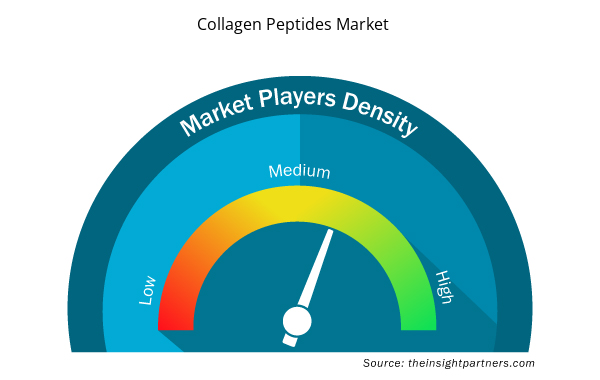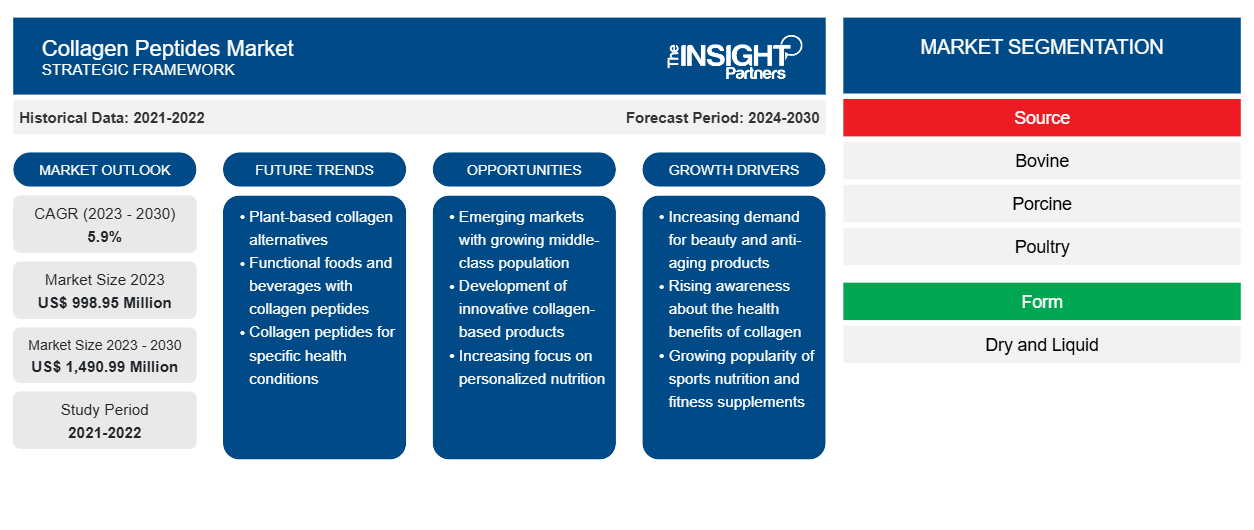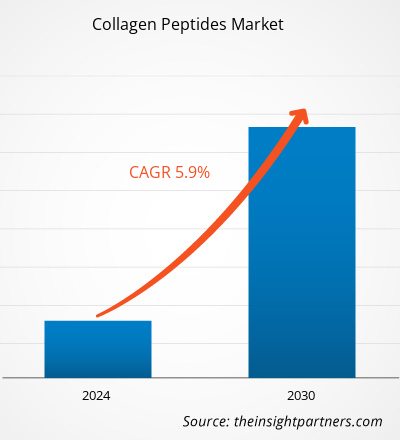[調査レポート] コラーゲンペプチド市場は2023年に9億9,895万米ドルと評価され、2030年までに14億9,099万米ドルに達すると予測されており、2023年から2030年にかけて5.9%のCAGRを記録すると予想されています。
世界のコラーゲンペプチド市場は競争が激しく、多数の地元、地域、世界のメーカーが製品の品質と革新性に基づいて競い合っています。いくつかのコラーゲンペプチドメーカーはコーシャおよびハラール認証を取得しており、世界市場での競争力を高めています。たとえば、大手コラーゲンメーカーの 1 つである Rousselot は、ハラールおよびコーシャ認証を受けた生産ユニットを持っています。さらに、同社は IFS、ISO 9001、GMP+、FCA 認証も取得しており、市場での地位を高めています。メーカーは、変化する顧客の好みに対応するために、製品革新と新製品開発にも投資しています。たとえば、Evonik Industries Inc. は最近、発酵プロセスを使用したビーガンフレンドリーなコラーゲンを発売しました。この取り組みにより、世界のコラーゲンペプチド市場のメーカーに有利な機会がもたらされると期待されています。
2022年には、北米が世界のコラーゲンペプチド市場で最大のシェアを占め、アジア太平洋地域は予測期間中に最高のCAGRを記録すると予測されています。コラーゲンペプチドは、粉末、カプセル、タブレット、グミなど、さまざまなサプリメント形式で使用されています。この地域での栄養補助食品の需要の高さが、コラーゲンペプチドの販売を主に牽引しています。そのため、栄養化粧品 業界では、消費者の要件を満たすためにコラーゲンペプチドをますます取り入れています。さらに、コラーゲンペプチドは、骨萎縮、骨密度の低下、骨の安定性に効果的です。したがって、幅広い適用範囲が、地域全体でコラーゲンペプチドの需要を促進しています。
要件に合わせてレポートをカスタマイズする
このレポートの一部、国レベルの分析、Excelデータパックなど、あらゆるレポートを無料でカスタマイズできます。また、スタートアップや大学向けのお得なオファーや割引もご利用いただけます。
- このレポートの主要な市場動向を入手してください。この無料サンプルには、市場動向から見積もりや予測に至るまでのデータ分析が含まれます。
COVID-19パンデミックがコラーゲンペプチド市場に与える影響
機能性食品や飲料、栄養補助食品の消費量の増加、タンパク質を豊富に含む製品への高い需要は、COVID-19パンデミックの発生前にコラーゲンペプチド市場の成長を後押しした主な要因です。しかし、これらの業界は2020年の発生後、前例のない課題に直面しました。
2021年、各国政府が以前に課していた制限の緩和を発表したことで、さまざまな経済が再開し、世界市場が活性化しました。さらに、メーカーはフル稼働を許可されたため、需要と供給のギャップやその他の影響を乗り越えることができました。2021年までに多くの国の国民の多くがワクチン接種を完了したため、コラーゲンペプチドメーカーは事業の再生に向けて生産量の増加に注力しました。
市場分析
海洋由来コラーゲンペプチドの需要急増によりコラーゲンペプチド市場の成長が促進される
魚、クラゲ、海綿動物、その他の無脊椎動物などの海洋生物は、コラーゲンペプチドの重要な供給源です。代謝適合性があり、宗教的制約がなく、動物病原体を含まないため、他の供給源に比べて非常に有利です。さらに、海洋由来のコラーゲンペプチドは、水溶性と代謝適合性があるため、生体材料として使用できます。そのため、さまざまな産業用途での利用が増えるにつれて、海洋由来のコラーゲンペプチドの需要が高まっています。
さらに、海洋由来のコラーゲンペプチドは伝染病を助長しません。陸上動物は多くの伝染病にかかっているため、産業での使用にはあまり好ましくありません。たとえば、牛はコラーゲンの大きな供給源ですが、BSEとTSEのリスクがあります。これらの要因により、海洋由来のコラーゲンペプチドは、はるかに簡単で安全で、より有望な代替品になります。したがって、需要の増加に伴い、メーカーはさまざまな製品を発売しています。たとえば、2021年1月、Darling Ingredientsは、Rousselotブランドの海洋コラーゲンペプチドであるPeptanを発表しました。この製品は、同社が栄養補助食品市場に参入するのに役立ちます。したがって、海洋由来コラーゲンの需要の高まりにより、予測期間中にコラーゲンペプチド市場に新たな機会が開かれると予想されます。
ソースベースの洞察
コラーゲンペプチド市場は、供給源に基づいて、牛、豚、鶏、海洋、その他に分かれています。牛セグメントは2022年に市場で最大のシェアを占めましたが、海洋セグメントは予測期間中に最も急速に成長しました。海洋コラーゲンペプチドは、主にさまざまな種類の魚、クラゲ、スポンジから得られます。したがって、牛や豚の代替品として海洋由来のコラーゲンペプチドの需要が高まっており、コラーゲンペプチド市場の成長に影響を与えると予測されています。
アプリケーションベースの洞察
用途に基づいて、コラーゲンペプチド市場は食品および飲料、医薬品および栄養補助食品、パーソナルケア、その他に分類されます。食品および飲料セグメントは、予測期間中に最高のCAGRを記録すると予想されます。乳製品では、テクスチャー化および安定化剤として使用されます。コラーゲン加水分解物はカルシウムイオンを結合し、その生物学的利用能を改善します。したがって、コラーゲンペプチドは、ミネラル欠乏症を管理するための機能性食品成分に使用できます。
コラーゲンペプチドは抗凝固剤として作用し、細胞や組織の損傷を軽減するため、冷蔵または冷凍温度で保存する必要がある食品に有益です。コラーゲンペプチドは、製品の感覚的、物理的、化学的特性を高め、維持するのに役立ちます。したがって、上記の特性により、コラーゲンペプチドは肉、飲料、スープなどのさまざまな製品の調理に使用されてきました。
コラーゲンペプチド市場で活動している主要企業は、GELITA AG、Rousselot BV、Titan Biotech Ltd、Tessenderlo Group NV、Ewald-Gelatine GmbH、BioCell Technology LLC、Lapi Gelatine SpA、Weishardt Holding SA、Nippi Collagen NA Inc、および Nitta Gelatin India Ltd です。これらの企業は、世界中で高まる消費者の需要に応え、専門ポートフォリオの製品範囲を拡大するために、新製品の発売と地理的拡大に重点を置いています。これらの企業は世界中に広く展開しており、これにより多数の顧客にサービスを提供し、その結果、市場シェアを拡大しています。
コラーゲンペプチド市場の地域別分析
予測期間を通じてコラーゲンペプチド市場に影響を与える地域的な傾向と要因は、Insight Partners のアナリストによって徹底的に説明されています。このセクションでは、北米、ヨーロッパ、アジア太平洋、中東、アフリカ、南米、中米にわたるコラーゲンペプチド市場のセグメントと地理についても説明します。

- コラーゲンペプチド市場の地域別データを入手
コラーゲンペプチド市場レポートの範囲
| レポート属性 | 詳細 |
|---|---|
| 2023年の市場規模 | 9億9,895万米ドル |
| 2030年までの市場規模 | 14億9,099万米ドル |
| 世界のCAGR(2023年~2030年) | 5.9% |
| 履歴データ | 2021-2022 |
| 予測期間 | 2024-2030 |
| 対象セグメント | 出典別
|
| 対象地域と国 | 北米
|
| 市場リーダーと主要企業プロフィール |
|
コラーゲンペプチド市場のプレーヤー密度:ビジネスダイナミクスへの影響を理解する
コラーゲンペプチド市場は、消費者の嗜好の変化、技術の進歩、製品の利点に対する認識の高まりなどの要因により、エンドユーザーの需要が高まり、急速に成長しています。需要が高まるにつれて、企業は提供を拡大し、消費者のニーズを満たすために革新し、新たなトレンドを活用し、市場の成長をさらに促進しています。
市場プレーヤー密度とは、特定の市場または業界内で活動している企業または会社の分布を指します。これは、特定の市場スペースに、その市場規模または総市場価値に対してどれだけの競合相手 (市場プレーヤー) が存在するかを示します。
コラーゲンペプチド市場で事業を展開している主要企業は次のとおりです。
- ジェリタAG
- ルーセロBV
- タイタンバイオテック株式会社
- テッセンデルログループNV
- エヴァルト・ゼラチン株式会社
免責事項:上記の企業は、特定の順序でランク付けされていません。

- コラーゲンペプチド市場のトップキープレーヤーの概要を入手
レポートの注目点
- 企業が効果的な長期戦略を策定するのに役立つコラーゲンペプチド市場の進歩的な業界動向
- 先進国と発展途上国の市場プレーヤーが採用しているビジネス成長戦略
- 2022年から2030年までの市場の定量分析
- コラーゲンペプチドの世界需要の推定
- コラーゲンペプチド市場におけるバイヤーとサプライヤーの有効性を示すポーターの5つの力の分析
- 競争市場の状況を理解するための最近の動向
- コラーゲンペプチド市場の市場動向と展望、成長の原動力と制約
- 商業的利益を支える市場戦略を強調することで意思決定プロセスを支援する
- さまざまなノードにおけるコラーゲンペプチド市場の規模
- コラーゲンペプチド業界の詳細な概要と動向
- 有望な成長機会のあるさまざまな地域のコラーゲンペプチド市場の規模
- 過去2年間の分析、基準年、CAGRによる予測(7年間)
- PEST分析とSWOT分析
- 市場規模価値/数量 - 世界、地域、国
- 業界と競争環境
- Excel データセット



Report Coverage
Revenue forecast, Company Analysis, Industry landscape, Growth factors, and Trends

Segment Covered
This text is related
to segments covered.

Regional Scope
North America, Europe, Asia Pacific, Middle East & Africa, South & Central America

Country Scope
This text is related
to country scope.
よくある質問
Based on source, bovine segments mainly have the largest revenue share. Bovine-based collagen peptide is a common food additive and supplement. It is primarily extracted from cows. The consumption of bovine collagen helps improve skin health and prevent bone loss. The body’s collagen production naturally decreases with age, and the deficiency can cause health issues related to bone, joints, and skin. Individuals exposed to excess sunlight are also at risk of decreased collagen production. Bovine collagen peptides supplements may help counter the effects of low collagen levels. Boiling cow bones or other cattle byproducts in water produces this collagen type. After the collagen is extracted in an aqueous solution, it is dried and powdered to form a final product. Bovine collagen has been found to improve Type I and III collagen levels in the human body. The skin is primarily built up of Types I and III collagen; thus, its intake in specified quantities helps reduce wrinkles, promote elasticity, and increase skin moisture.
The major players operating in the global collagen peptides market are GELITA AG, Rousselot BV, Titan Biotech Ltd, Tessenderlo Group NV, Ewald-Gelatine GmbH, BioCell Technology LLC, Lapi Gelatine SpA, Weishardt Holding SA, Nippi Collagen NA Inc, and Nitta Gelatin India Ltd.
Surging Demand for marine-sourced collagen peptides to provide potential market opportunities in the coming years for the collagen peptides. Marine organisms such as fish, jellyfish, sponges, and other invertebrates harbor a significant source of collagen peptides. They are highly advantageous over other sources, as they are metabolically compatible, lack religious constraints, and are free of animal pathogens. Marine-sourced collagen peptide is majorly used for skincare product manufacturing. It is a versatile compound capable of healing skin injuries of varying severity and delaying the natural human aging process. Moreover, marine-sourced collagen peptides can be used as a biomaterial owing to its water solubility and metabolic compatibility. Thus, the demand for marine-sourced collagen peptide is increasing with its rising utilization for different industrial applications.
North America accounted for the largest share of the global collagen peptides market. Collagen peptide-based supplements are becoming increasingly popular, particularly for the prevention and treatment of arthritis. Geriatric population of North America are opting for bone and joint health supplements to improve and maintain their health and well-being. According to the Centers for Disease Control and Prevention (CDC), November 3, 2021 report, ~54 million people in the US were diagnosed with severe joint pain caused by arthritis. In the US, 24% of all adults, or 58.5 million people, have arthritis. Owing to the high frequency of arthritis, collagen peptide-based supplements for bone and joint health are in high demand in North America.
Based on the application, food and beverages segment is projected to grow at the fastest CAGR over the forecast period. Collagen peptides are used in various food and beverages such as dairy products, confectioneries, and beverages. It improves the chewiness, foam stabilization, and texture of confectioneries. Additionally, in dairy products, it is used as a texturization and stabilization agent. Collagen peptides act as a binding agent for ingredients used in nutritional bars, enhancing their softness. As a result of increased health consciousness, food manufacturers prefer collagen peptides to develop nutritious food products. Collagen hydrolysates can attach calcium ions, improving their bioavailability. Thus, collagen peptides can be used in functional food ingredients to manage mineral deficiencies.
Strategic development initiatives by key market players are driving the collagen peptides market. Various end-use industries are adopting business expansion strategies and scaling production capacity to provide better customer satisfaction. For instance, in July 2020, Rousselot and Giusto Faravelli announced a distribution partnership in Italy, effective from October 2020. Under this partnership, Faravelli distributes food and pharmaceutical gelatins, hydrolyzed collagens, and biomedical gelatins across Italy. Thus, expanding businesses to other regions or countries to cater to the increasing demand by consumers drives the market growth. Such development strategies by collagen peptide manufacturers extend their reach and gain a competitive edge in international markets.
Trends and growth analysis reports related to Food and Beverages : READ MORE..
The List of Companies - Collagen Peptides Market
- GELITA AG
- Rousselot BV
- Titan Biotech Ltd
- Tessenderlo Group NV
- Ewald-Gelatine GmbH
- BioCell Technology LLC
- Lapi Gelatine SpA
- Weishardt Holding SA
- Nippi Collagen NA Inc
- Nitta Gelatin India Ltd.
The Insight Partners performs research in 4 major stages: Data Collection & Secondary Research, Primary Research, Data Analysis and Data Triangulation & Final Review.
- Data Collection and Secondary Research:
As a market research and consulting firm operating from a decade, we have published and advised several client across the globe. First step for any study will start with an assessment of currently available data and insights from existing reports. Further, historical and current market information is collected from Investor Presentations, Annual Reports, SEC Filings, etc., and other information related to company’s performance and market positioning are gathered from Paid Databases (Factiva, Hoovers, and Reuters) and various other publications available in public domain.
Several associations trade associates, technical forums, institutes, societies and organization are accessed to gain technical as well as market related insights through their publications such as research papers, blogs and press releases related to the studies are referred to get cues about the market. Further, white papers, journals, magazines, and other news articles published in last 3 years are scrutinized and analyzed to understand the current market trends.
- Primary Research:
The primarily interview analysis comprise of data obtained from industry participants interview and answers to survey questions gathered by in-house primary team.
For primary research, interviews are conducted with industry experts/CEOs/Marketing Managers/VPs/Subject Matter Experts from both demand and supply side to get a 360-degree view of the market. The primary team conducts several interviews based on the complexity of the markets to understand the various market trends and dynamics which makes research more credible and precise.
A typical research interview fulfils the following functions:
- Provides first-hand information on the market size, market trends, growth trends, competitive landscape, and outlook
- Validates and strengthens in-house secondary research findings
- Develops the analysis team’s expertise and market understanding
Primary research involves email interactions and telephone interviews for each market, category, segment, and sub-segment across geographies. The participants who typically take part in such a process include, but are not limited to:
- Industry participants: VPs, business development managers, market intelligence managers and national sales managers
- Outside experts: Valuation experts, research analysts and key opinion leaders specializing in the electronics and semiconductor industry.
Below is the breakup of our primary respondents by company, designation, and region:

Once we receive the confirmation from primary research sources or primary respondents, we finalize the base year market estimation and forecast the data as per the macroeconomic and microeconomic factors assessed during data collection.
- Data Analysis:
Once data is validated through both secondary as well as primary respondents, we finalize the market estimations by hypothesis formulation and factor analysis at regional and country level.
- Macro-Economic Factor Analysis:
We analyse macroeconomic indicators such the gross domestic product (GDP), increase in the demand for goods and services across industries, technological advancement, regional economic growth, governmental policies, the influence of COVID-19, PEST analysis, and other aspects. This analysis aids in setting benchmarks for various nations/regions and approximating market splits. Additionally, the general trend of the aforementioned components aid in determining the market's development possibilities.
- Country Level Data:
Various factors that are especially aligned to the country are taken into account to determine the market size for a certain area and country, including the presence of vendors, such as headquarters and offices, the country's GDP, demand patterns, and industry growth. To comprehend the market dynamics for the nation, a number of growth variables, inhibitors, application areas, and current market trends are researched. The aforementioned elements aid in determining the country's overall market's growth potential.
- Company Profile:
The “Table of Contents” is formulated by listing and analyzing more than 25 - 30 companies operating in the market ecosystem across geographies. However, we profile only 10 companies as a standard practice in our syndicate reports. These 10 companies comprise leading, emerging, and regional players. Nonetheless, our analysis is not restricted to the 10 listed companies, we also analyze other companies present in the market to develop a holistic view and understand the prevailing trends. The “Company Profiles” section in the report covers key facts, business description, products & services, financial information, SWOT analysis, and key developments. The financial information presented is extracted from the annual reports and official documents of the publicly listed companies. Upon collecting the information for the sections of respective companies, we verify them via various primary sources and then compile the data in respective company profiles. The company level information helps us in deriving the base number as well as in forecasting the market size.
- Developing Base Number:
Aggregation of sales statistics (2020-2022) and macro-economic factor, and other secondary and primary research insights are utilized to arrive at base number and related market shares for 2022. The data gaps are identified in this step and relevant market data is analyzed, collected from paid primary interviews or databases. On finalizing the base year market size, forecasts are developed on the basis of macro-economic, industry and market growth factors and company level analysis.
- Data Triangulation and Final Review:
The market findings and base year market size calculations are validated from supply as well as demand side. Demand side validations are based on macro-economic factor analysis and benchmarks for respective regions and countries. In case of supply side validations, revenues of major companies are estimated (in case not available) based on industry benchmark, approximate number of employees, product portfolio, and primary interviews revenues are gathered. Further revenue from target product/service segment is assessed to avoid overshooting of market statistics. In case of heavy deviations between supply and demand side values, all thes steps are repeated to achieve synchronization.
We follow an iterative model, wherein we share our research findings with Subject Matter Experts (SME’s) and Key Opinion Leaders (KOLs) until consensus view of the market is not formulated – this model negates any drastic deviation in the opinions of experts. Only validated and universally acceptable research findings are quoted in our reports.
We have important check points that we use to validate our research findings – which we call – data triangulation, where we validate the information, we generate from secondary sources with primary interviews and then we re-validate with our internal data bases and Subject matter experts. This comprehensive model enables us to deliver high quality, reliable data in shortest possible time.


 このレポートの無料サンプルを入手する
このレポートの無料サンプルを入手する